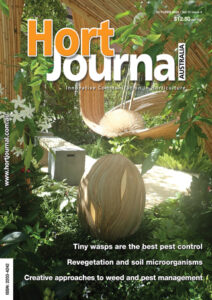
Horticulture, a passion fit for a king
Only after the funeral of Queen Elizabeth II did I realise how many Australian organisations had a title that included ‘Royal’. Obviously, we have a Royal Australian Navy and a Royal Air Force for example but there are many more. There are at least ten variations of Royal Agricultural Societies, three Royal Horticultural Societies and a couple of Royal Botanic Gardens. There are automobile clubs, yacht clubs, golf clubs, hospitals and colleges, not to mention hotels and theatres. The British monarchy has been an integral part of Australian life for over two hundred and thirty years. How will a change of monarch affect this? Probably not a lot. Despite any outcome of the republican debate, I feel the influence of the British monarchy will be felt in Australia for some time and will continue to grace the cover of many a magazine.
Some of the organisations I have mentioned have been incorporated by royal charter dating as far back as Queen Victoria, but others are ‘royal’ because they have a patron who is part of the Royal Family. It will fall to the new king to either renew these patronages, pass them on to some other member of the royal family or discontinue the patronage. I feel certain that given the interest in the environment and gardening generally, the horticulture sector can count on the support of the new monarchy.
As the celebration of life for Queen Elizabeth II draws to a close. Social media has been full of tributes from people across the globe. Queen Elizabeth II had a keen interest in horticulture and the environment, as did Prince Philip and the now King Charles III.
Ours is an industry that sees many elderly people committed to their passion and continuing to work. Whether you are a monarchist or not, you have to admire Queen Elizabeth for her commitment.
Every year, the Queen along with other members of the Royal Family were seen at the Royal Horticultural Society Chelsea Garden Show, admiring the plants and show gardens, and interacting with exhibitors and visitors to the show, including many Australian exhibitors.
This made me think about how many plants have been named in honour of many of the British monarchy or to commemorate coronations, births and jubilees. Everything from roses to agapanthus, clematis and chrysanthemum. King Edward VII in 1902 had a variety of potato, which is particularly useful for chips, named in his honour for his coronation. Queen Victoria has more than a dozen plants bearing her name and so has Queen Elizabeth II.
A study carried out by the Royal Botanic Gardens, Kew, about six years ago estimated there are about 390,900 plants known to science and about 2000 added each year. Australia is one of the hotspots, and they suggested that botanists from Australia, China or Brazil were the most likely to find and name a new plant. King Charles III is known for his passion for plants and the environment, so it is likely that some new species could be named in his honour, and the naming may not simply be because of who he is, but because he champions causes close to our hearts.
Enjoy the read.
Karen Smith and your Hort Journal team
Main photo: The Orchard Bridge’ overall Show Garden winner Singapore Garden Festival (Image: Karen Smith)
